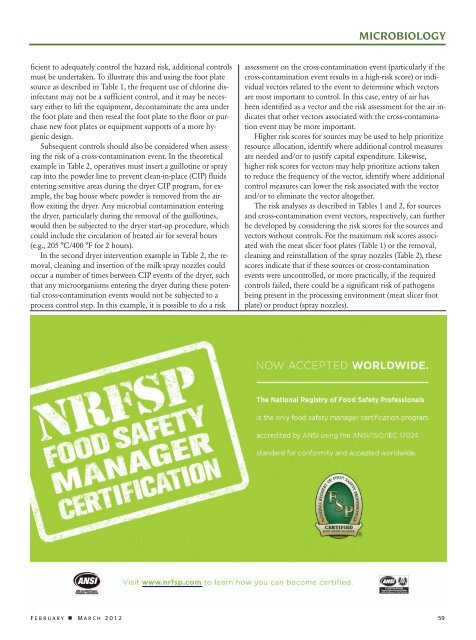Food Safety Magazine, February/March 2012
Food Safety Magazine, February/March 2012
Food Safety Magazine, February/March 2012
You also want an ePaper? Increase the reach of your titles
YUMPU automatically turns print PDFs into web optimized ePapers that Google loves.
MICROBIOLOGYficient to adequately control the hazard risk, additional controlsmust be undertaken. To illustrate this and using the foot platesource as described in Table 1, the frequent use of chlorine disinfectantmay not be a sufficient control, and it may be necessaryeither to lift the equipment, decontaminate the area underthe foot plate and then reseal the foot plate to the floor or purchasenew foot plates or equipment supports of a more hygienicdesign.Subsequent controls should also be considered when assessingthe risk of a cross-contamination event. In the theoreticalexample in Table 2, operatives must insert a guillotine or spraycap into the powder line to prevent clean-in-place (CIP) fluidsentering sensitive areas during the dryer CIP program, for example,the bag house where powder is removed from the airflowexiting the dryer. Any microbial contamination enteringthe dryer, particularly during the removal of the guillotines,would then be subjected to the dryer start-up procedure, whichcould include the circulation of heated air for several hours(e.g., 205 °C/400 °F for 2 hours).In the second dryer intervention example in Table 2, the removal,cleaning and insertion of the milk spray nozzles couldoccur a number of times between CIP events of the dryer, suchthat any microorganisms entering the dryer during these potentialcross-contamination events would not be subjected to aprocess control step. In this example, it is possible to do a riskassessment on the cross-contamination event (particularly if thecross-contamination event results in a high-risk score) or individualvectors related to the event to determine which vectorsare most important to control. In this case, entry of air hasbeen identified as a vector and the risk assessment for the air indicatesthat other vectors associated with the cross-contaminationevent may be more important.Higher risk scores for sources may be used to help prioritizeresource allocation, identify where additional control measuresare needed and/or to justify capital expenditure. Likewise,higher risk scores for vectors may help prioritize actions takento reduce the frequency of the vector, identify where additionalcontrol measures can lower the risk associated with the vectorand/or to eliminate the vector altogether.The risk analyses as described in Tables 1 and 2, for sourcesand cross-contamination event vectors, respectively, can furtherbe developed by considering the risk scores for the sources andvectors without controls. For the maximum risk scores associatedwith the meat slicer foot plates (Table 1) or the removal,cleaning and reinstallation of the spray nozzles (Table 2), thesescores indicate that if these sources or cross-contaminationevents were uncontrolled, or more practically, if the requiredcontrols failed, there could be a significant risk of pathogensbeing present in the processing environment (meat slicer footplate) or product (spray nozzles).F E B R U A R Y n M A R C H 2 0 1 2 59






![Otomatik indirilmez ise tıklayınız [Download]](https://img.yumpu.com/44170525/1/190x190/otomatik-indirilmez-ise-taklayanaz-download.jpg?quality=85)









